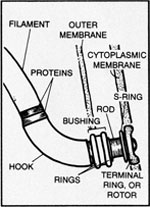Rotary engines

Rotating devices, such as wheels, gears and rotary motors do not seem to feature in the natural world of living things. Evolutionists would claim that they know why. They believe they can explain the origin of ‘push-pull’ engines (like muscles) for motion, by arguing that one can imagine ‘partially evolved’ stages which might be useful (and thus favoured by selection). For instance, an early blob-like ancestor could get benefit out of a very basic ability to contract itself in a given direction—away from an enemy or towards food.
Thus, they would claim, the reason why animals have not evolved wheels is not so much because there were no plentiful highways to which to adapt—rather, it is because such a rotary device must be largely functional from its, first appearance. A wheel which was merely on its way to being round, or which was not yet able to rotate around its axle, for instance, would be a hindrance, and thus eliminated. It seems impossible to imagine any ‘part-way’ rotary engine working for a living thing, unlike a push-pull engine.

It is therefore fascinating to note that common bacteria, including Salmonella and Escherichia coli (which are present in vast numbers in everyone’s intestine) have now been shown to possess rotary engines. Protruding from the outer membrane of the creature are whip like bundles of filamentous structures called flagella, which are rotated by tiny molecular motors to propel the organism.
Salmonella, for instance, have six or seven of these engines working simultaneously. Although they are only 30 millionths of a millimetre in diameter, these engines are analogous to man-made electric motors in that they have a rotor which revolves inside a stationary ring, or stator. These incredibly energy-efficient motors whiz around at the incredible speed of some 15,000 revolutions per minute!
A team of skilled Japanese biophysicists has been spending millions of dollars for some years trying to understand exactly how these motors work. So far, it is not yet fully known even how the molecules in the flagellar filaments are arranged. The money being spent on research is in the hope that humans will one day be able to imitate this incredible design information in order to make use of this fantastic microtechnology.
It can be safely stated that no one has the faintest idea how such incredibly complicated arrangements of matter could have possibly, conceivably, imaginably evolved by selection of chance mutations. The alternative explanation, that they were created, is much more reasonable.
[Information from Scientific American. September. 1991, pp. 124—125]


Readers’ comments
Comments are automatically closed 14 days after publication.